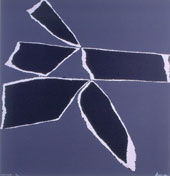

| Home | Art | Books | Order | Site Map |
 |
|
 |
|||||||||||
|
|||||||||||||
|
Night Flight, by Arthur Secunda | ||||||||||||||||||||||||||||||||

Personal Reflections, by Arthur SecundaNight Flight is a theme that has obsessed me ever since I first saw Brueghel's "The Fall of Icarus." In Brueghel's great masterpiece, you actually have to search out Icarus's fall into the ocean. There is a vast landscape and seascape, the daily activities of life are going on as usual. This extraordinary phenomenon, Icarus's fall, is taking place amidst mundane and unextraordinay events. The theatricality of that painting has always been universal and poignant to me. In many ways and times, I have tried to express the idea of silence in the context of flight, particularly at night. Combining the three elements - silence, night, and flight - is a challenge that summons up ideas of mysticism and dreams. As to the formal positioning of Night Flight into the perimeters of the picture, I owe a debt of gratitude to Kenneth Noland and his magnificent circles and earlier pieces that relate to cats' paws, if I recall correctly. The images are sort of propeller shapes which have to do with the definition of the picture plane in a revolving or cyclical pattern. My own way to reflect this compositional concept of confined contours reaching toward the edges of the picture, was to create a collage out of torn black cardboard, leaving the edges as wavy and irregular as possible. I then placed the five pieces that I tore out in an emblematic pattern that is both geometric and haphazard at the same time, this being a favorite device of mine in all the mediums, thanks to the study of Cezanne's brushstrokes. This print, Night Flight, was derived from a collage which, in turn, comes from an earlier oil painting, unfortunately now destroyed. The painting, done about 1961, was called Night Icarus, and was bathed in deep Prussian and cobalt blues, ceruleans and violets. Its shapes and composition were similar to the Night Flight idea in the sense that the forms were mostly visible by the tactility of the paint, or, in the case of Night Flight, by the textures of the torn board. I also relate the arrangement of these forms to a Japanese zen rock garden. In Buddhist culture, phenomena or reality is accepted as it happened. If the mind, however, can click in different modes or stations, it can also see very structured, formal, perfectly arranged "things" in that same reality. The quasi-triangle that appears as the negative shape in the middle of Night Flight's five forms, is the fulcrum or pivot by which this propeller-like bird - this flapping sentient animal is floating through the night. Though it is difficult to work in black and white only, it's even more difficult to work in gray and black. The mood it sets is inevitable because black has a certain symbolic strength and meaning no matter what we do to it. The effect of the torn black board translated here into the silkscreen medium via these light gray, expressionist tear lines, is both brutal through the violence of the tear, and delicate through the nuanced, thin, "uncorrected," filigreed tear lines of the paper's fibre. The background is a blackboard gray, as if one could write on it with chalk. The image of the bird, then, literally floats against that blackboard and the arrangement with this leaf-like form at the bottom seems to propel or turn the bird in space. The tight ambiance exudes quietude, which was the goal: achieving visual silence, a sense of flight, and occurring at night. The artist Morris Broderson, whom I knew in the early sixties when I was represented by the Ankrum Gallery in Los Angeles, was a deaf-mute. The recurring theme in his work was silence which was the world in which he lived. Though pictorially my work had nothing to do with his, the idea of silence as a subject was initially introduced to me by Morris and one of his collectors who happened to be a friend of mine, art historian MacKinley Helm. Finally, another aspect of Night Flight is that the five forms which make up its abstract anatomy are related to the human body. They could be a head, two arms, and two legs, which suggest a secondary subliminal orientation of a black figure dancing silently, with limbs in movement turning, dancing, hopping, twirling, and, in an awkward way, rather gracefully. The effect of the "limbs" reaching out to the edges or contours of the picture plane, not quite touching (but almost touching), adds to the tension of the movements, and encloses the subject in a mysterious hall of darkness, partially as prisoner, partially as transient space traveler. Note: Night Flight was printed by Arthur Secunda in 1981 for five exhibitions of his work in Japan. While numerous copies of the work were sold at that time, the print was never formally published and released for general distribution. Pierian Press Fine Art Editions has acquired the remainder of this edition and is making the print available to the general public for the first time.
|
|||||||||||||||||||||||||||||||||
|
| Home |
Art |
Books | Order | Contact Us | Site Map | Admin | |
|
|
© 2002-2025 Pierian Press. All rights reserved. |